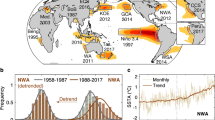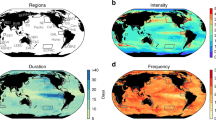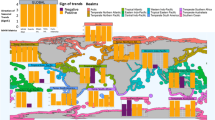Abstract
Marine heatwaves (MHWs)—discrete but prolonged periods of anomalously warm ocean temperatures—can drastically alter ocean ecosystems, with profound ecological and socioeconomic impacts1,2,3,4,5,6,7,8. Considerable effort has been directed at understanding the patterns, drivers and trends of MHWs globally9,10,11. Typically, MHWs are characterized on the basis of their intensity and persistence at a given location—an approach that is particularly relevant for corals and other sessile organisms that must endure increased temperatures. However, many ecologically and commercially important marine species respond to environmental disruptions by relocating to favourable habitats, and dramatic range shifts of mobile marine species are among the conspicuous impacts of MHWs1,4,12,13. Whereas spatial temperature shifts have been studied extensively in the context of long-term warming trends14,15,16,17,18, they are unaccounted for in existing global MHW analyses. Here we introduce thermal displacement as a metric that characterizes MHWs by the spatial shifts of surface temperature contours, instead of by local temperature anomalies, and use an observation-based global sea surface temperature dataset to calculate thermal displacements for all MHWs from 1982 to 2019. We show that thermal displacements during MHWs vary from tens to thousands of kilometres across the world’s oceans and do not correlate spatially with MHW intensity. Furthermore, short-term thermal displacements during MHWs are of comparable magnitude to century-scale shifts inferred from warming trends18, although their global spatial patterns are very different. These results expand our understanding of MHWs and their potential impacts on marine species, revealing which regions are most susceptible to thermal displacement, and how such shifts may change under projected ocean warming. The findings also highlight the need for marine resource management to account for MHW-driven spatial shifts, which are of comparable scale to those associated with long-term climate change and are already happening.
This is a preview of subscription content, access via your institution
Access options
Access Nature and 54 other Nature Portfolio journals
Get Nature+, our best-value online-access subscription
$29.99 / 30 days
cancel any time
Subscribe to this journal
Receive 51 print issues and online access
$199.00 per year
only $3.90 per issue
Buy this article
- Purchase on Springer Link
- Instant access to full article PDF
Prices may be subject to local taxes which are calculated during checkout




Similar content being viewed by others
Data availability
NOAA High Resolution OISSTv2 data were obtained from NOAA/OAR/ESRL PSL, Boulder, Colorado, USA, at https://www.esrl.noaa.gov/psd/. CMIP5 outputs were obtained from Earth System Grid Federation (https://esgf-node.llnl.gov/projects/cmip5/). The CMIP5 ensemble mean SST fields used in this analysis are available from J.D.S. (james.d.scott@noaa.gov).
Code availability
All analyses were performed using MATLAB. Codes can be accessed at https://github.com/mjacox/Thermal_Displacement.
References
Mills, K. et al. Fisheries management in a changing climate: lessons from the 2012 ocean heat wave in the Northwest Atlantic. Oceanography 26, 191–195 (2013).
Wernberg, T. et al. An extreme climatic event alters marine ecosystem structure in a global biodiversity hotspot. Nat. Clim. Chang. 3, 78–82 (2013).
Thomson, J. A. et al. Extreme temperatures, foundation species, and abrupt ecosystem change: an example from an iconic seagrass ecosystem. Glob. Change Biol. 21, 1463–1474 (2015).
Cavole, L. M. et al. Biological impacts of the 2013–2015 warm-water anomaly in the Northeast Pacific: winners, losers, and the future. Oceanography 29, 273–285 (2016).
Hughes, T. P. et al. Global warming and recurrent mass bleaching of corals. Nature 543, 373–377 (2017).
Babcock, R. C. et al. Severe continental-scale impacts of climate change are happening now: extreme climate events impact marine habitat forming communities along 45% of Australia’s coast. Front. Mar. Sci. 6, 411 (2019); corrigendum 6, 558 (2019).
Smale, D. A. et al. Marine heatwaves threaten global biodiversity and the provision of ecosystem services. Nat. Clim. Chang. 9, 306–312 (2019).
Oliver, E. C. et al. The unprecedented 2015/16 Tasman Sea marine heatwave. Nat. Commun. 8, 16101 (2017).
Oliver, E. C. et al. Longer and more frequent marine heatwaves over the past century. Nat. Commun. 9, 1324 (2018).
Frölicher, T. L., Fischer, E. M. & Gruber, N. Marine heatwaves under global warming. Nature 560, 360–364 (2018).
Holbrook, N. J. et al. A global assessment of marine heatwaves and their drivers. Nat. Commun. 10, 2624 (2019).
Ñiquen, M. & Bouchon, M. Impact of El Niño events on pelagic fisheries in Peruvian waters. Deep Sea Res. Part II 51, 563–574 (2004).
Walker, H. J. et al. Unusual occurrences of fishes in the southern California current system during the warm water period of 2014–2018. Estuar. Coast. Shelf Sci. 236, 106634 (2020).
Perry, A. L., Low, P. J., Ellis, J. R. & Reynolds, J. D. Climate change and distribution shifts in marine fishes. Science 308, 1912–1915 (2005).
Sorte, C. J., Williams, S. L. & Carlton, J. T. Marine range shifts and species introductions: comparative spread rates and community impacts. Glob. Ecol. Biogeogr. 19, 303–316 (2010).
Pinsky, M. L., Worm, B., Fogarty, M. J., Sarmiento, J. L. & Levin, S. A. Marine taxa track local climate velocities. Science 341, 1239–1242 (2013).
Poloczanska, E. S. et al. Global imprint of climate change on marine life. Nat. Clim. Chang. 3, 919–925 (2013).
Burrows, M. T. et al. The pace of shifting climate in marine and terrestrial ecosystems. Science 334, 652–655 (2011).
Pearce, A. F. & Feng, M. The rise and fall of the “marine heat wave” off Western Australia during the summer of 2010/2011. J. Mar. Syst. 111–112, 139–156 (2013).
Bond, N. A., Cronin, M. F., Freeland, H. & Mantua, N. Causes and impacts of the 2014 warm anomaly in the NE Pacific. Geophys. Res. Lett. 42, 3414–3420 (2015).
Hobday, A. J. et al. A hierarchical approach to defining marine heatwaves. Prog. Oceanogr. 141, 227–238 (2016).
Perkins, S. E. & Alexander, L. V. On the measurement of heat waves. J. Clim. 26, 4500–4517 (2013).
Brito-Morales, I. et al. Climate velocity can inform conservation in a warming world. Trends Ecol. Evol. 33, 441–457 (2018).
Di Lorenzo, E. & Mantua, N. Multi-year persistence of the 2014/15 North Pacific marine heatwave. Nat. Clim. Chang. 6, 1042–1047 (2016).
Schwing, F. B. et al. Delayed coastal upwelling along the US West Coast in 2005: a historical perspective. Geophys. Res. Lett. 33, L22S01 (2006).
Brodeur, R. D. et al. Anomalous pelagic nekton abundance, distribution, and apparent recruitment in the northern California Current in 2004 and 2005. Geophys. Res. Lett. 33, L22S08 (2006).
Chen, K., Gawarkiewicz, G. G., Lentz, S. J. & Bane, J. M. Diagnosing the warming of the northeastern US coastal ocean in 2012: a linkage between the atmospheric jet stream variability and ocean response. J. Geophys. Res. 119, 218–227 (2014).
Lea, R. N. & Rosenblatt, R. H. Observations on fishes associated with the 1997–98 El Niño off California. Cal. Coop. Ocean. Fish. 41, 117–129 (2000).
Pearcy, W. G. Marine nekton off Oregon and the 1997–98 El Niño. Prog. Oceanogr. 54, 399–403 (2002).
Loarie, S. R. et al. The velocity of climate change. Nature 462, 1052–1055 (2009).
Jacox, M. G. Marine heatwaves in a changing climate. Nature 571, 485–487 (2019).
Seager, R. et al. Strengthening tropical Pacific zonal sea surface temperature gradient consistent with rising greenhouse gases. Nat. Clim. Chang. 9, 517–522 (2019).
Link, J. S., Nye, J. A. & Hare, J. A. Guidelines for incorporating fish distribution shifts into a stock assessment context. Fish Fish. 12, 461–469 (2011).
Rogers, L. A. et al. Shifting habitats expose fishing communities to risk under climate change. Nat. Clim. Chang. 9, 512–516 (2019).
Pinsky, M. L. & Fogarty, M. Lagged social-ecological responses to climate and range shifts in fisheries. Clim. Change 115, 883–891 (2012).
Briscoe, D. K. et al. Ecological bridges and barriers in pelagic ecosystems. Deep Sea Res. Part II 140, 182–192 (2017).
Sunday, J. M. et al. Species traits and climate velocity explain geographic range shifts in an ocean-warming hotspot. Ecol. Lett. 18, 944–953 (2015).
Reynolds, R. W. et al. Daily high-resolution-blended analyses for sea surface temperature. J. Clim. 20, 5473–5496 (2007).
Banzon, V., Smith, T. M., Chin, T. M., Liu, C. & Hankins, W. A long-term record of blended satellite and in situ sea-surface temperature for climate monitoring, modeling and environmental studies. Earth Syst. Sci. Data 8, 165–176 (2016).
Alexander, M. A. et al. Projected sea surface temperatures over the 21st century: changes in the mean, variability and extremes for large marine ecosystem regions of Northern Oceans. Elementa Sci. Anthrop. 6, 9 (2018).
Scannell, H. A., Pershing, A. J., Alexander, M. A., Thomas, A. C. & Mills, K. E. Frequency of marine heatwaves in the North Atlantic and North Pacific since 1950. Geophys. Res. Lett. 43, 2069–2076 (2016).
Hu, Z. Z., Kumar, A., Jha, B., Zhu, J. & Huang, B. Persistence and predictions of the remarkable warm anomaly in the northeastern Pacific Ocean during 2014–16. J. Clim. 30, 689–702 (2017).
Doi, T., Behera, S. K. & Yamagata, T. Merits of a 108-member ensemble system in ENSO and IOD predictions. J. Clim. 32, 957–972 (2019).
Jacox, M., Tommasi, D., Alexander, M., Hervieux, G. & Stock, C. Predicting the evolution of the 2014-16 California Current System marine heatwave from an ensemble of coupled global climate forecasts. Front. Mar. Sci. 6, 497 (2019).
Romanou, A., Rossow, W. B. & Chou, S. H. Decorrelation scales of high-resolution turbulent fluxes at the ocean surface and a method to fill in gaps in satellite data products. J. Clim. 19, 3378–3393 (2006).
Hobday, A. J. et al. Categorizing and naming marine heatwaves. Oceanography31, 162–173 (2018).
Frölicher, T. L. & Laufkötter, C. Emerging risks from marine heat waves. Nat. Commun. 9, 650 (2018).
Diffenbaugh, N. S. & Ashfaq, M. Intensification of hot extremes in the United States. Geophys. Res. Lett. 37, L15701 (2010).
Acknowledgements
The idea for this study derived from discussions of the NOAA/NMFS Spatial Indicators working group, led by L. Barnett and E. Ward. We thank L. Barnett, C. Harvey, M. Hunsicker and A. O. Shelton for discussions and for comments on an earlier version of the manuscript. This study was supported by funding from the NOAA Climate Program Office’s Coastal and Ocean Climate Applications programme, the Modeling, Analysis, Predictions, and Projections programme and the NOAA Fisheries Office of Science and Technology (grants NA17OAR4310268 and NA17OAR4310108).
Author information
Authors and Affiliations
Contributions
M.G.J. conceived the study, performed the heatwave analysis and drafted the manuscript. M.A.A. and S.J.B. contributed to the interpretation and presentation of the results. J.D.S. processed the CMIP5 output. All authors revised the manuscript.
Corresponding author
Ethics declarations
Competing interests
The authors declare no competing interests.
Additional information
Peer review information Nature thanks Mark R. Payne, Laurene Pecuchet, Robert Schlegel and the other, anonymous, reviewer(s) for their contribution to the peer review of this work.
Publisher’s note Springer Nature remains neutral with regard to jurisdictional claims in published maps and institutional affiliations.
Extended data figures and tables
Extended Data Fig. 1 Distributions of MHW intensity and thermal displacement.
a, b, Histograms of MHW intensity (a) and thermal displacement (b) are shown for months with active MHWs from 1982 to 2019, aggregated across all OISST grid cells without ice cover. Vertical lines indicate medians (solid blue lines), 25th and 75th percentiles (dashed blue lines) and means (solid red lines) of each distribution.
Extended Data Fig. 2 Statistics of MHW intensity and thermal displacement.
a–h, Median (a, b), 25th–75th percentile range (c, d), minimum (e, f) and maximum (g, h) values of the MHW intensity (a, c, e, g) and thermal displacement (b, d, f, h) calculated across all MHW events from 1982 to 2019.
Extended Data Fig. 3 Spatial variability in thermal displacement is more dependent on spatial SST gradients than on MHW intensity.
a, b, Colours represent the number of 0.25° OISST grid cells that fall into each bin of thermal displacement and MHW intensity (a) or SST gradient (b). The sum of grid cells in all bins is the total number of ice-free OISST grid cells (n ≈ 500,000). Spearman rank correlations are r = −0.27 (a) and r = −0.81 (b).
Extended Data Fig. 4 Temporal variability in thermal displacement is dependent on MHW intensity for much of the global ocean.
Spearman rank correlation coefficients between MHW intensity and thermal displacement are shown for each grid cell. Locations where correlations are insignificant at the 95% significance level are greyed out. Significance calculations assume that each MHW event in a given location is statistically independent.
Extended Data Fig. 5 Thermal displacement methodology.
Steps for calculating thermal displacement are illustrated for a sample location in the Gulf of Alaska (145° W, 50° N). For each ice-free grid cell in the global ocean (n ≈ 500,000), the following steps are taken. a, The 1982–2011 monthly climatological temperature (grey) is calculated from the OISSTv2 data (magenta). b, The monthly climatology is subtracted to obtain monthly anomalies (magenta), which are then linearly detrended (black). c, MHWs (red) are identified as months in which the detrended SST anomaly (black) exceeds a seasonally varying 90th-percentile threshold (dotted black line). For each month with an MHW occurring (August 2019 is highlighted here for example), the detrended SST anomaly (1.3 °C in this case; d) is subtracted from the observed SST (10.3 °C; e) to obtain the ‘normal’ temperature for that month of the year corrected for the warming trend (9.0 °C). e, Thermal displacement is the shortest distance (521 km; white arrow) to SST at or below the ‘normal’ temperature (cyan contour). For the future projections, the same methodology is used after adding the mean projected SST change to the time series in a.
Extended Data Fig. 6 Frequency and duration of MHW events.
a–c, For each grid cell, MHW frequency (a), median duration (b) and maximum duration (c), calculated from monthly mean SST anomalies, are shown for 1982–2019.
Extended Data Fig. 7 MHW definitions based on daily versus monthly SST data are consistent.
a–i, SST anomaly time series are shown for each of the locations in Fig. 3. Daily data are shown as lines and vertical bars depict monthly data. MHWs defined from the daily data (using a 90th-percentile threshold, a five-day minimum duration and at least two days separating distinct events) are shown as red lines. MHWs defined from the monthly data (using a 90th-percentile threshold and a one-month minimum duration) are shown as purple bars. The SST anomaly thresholds used to define MHWs in each location are shown as red dashed (daily) and purple dotted (monthly) lines, which are often overlapping.
Extended Data Fig. 8 Marine heatwaves and their influence on thermal habitat redistribution globally, calculated with a fixed historical baseline.
a, Median MHW intensity (the SST anomaly associated with an MHW) from 1982 to 2019, calculated at each grid cell from all months with an active MHW. c, Median thermal displacement associated with MHWs. Thermal displacements can be in any direction (see Methods). White regions have seasonal or permanent sea ice cover. b, d, Zonal median values of MHW intensity and thermal displacement, with bands indicating the 25th–75th and 10th–90th percentile ranges. In contrast to Fig. 1, MHWs here were calculated without detrending SST anomalies relative to the 1982–2011 climatology.
Extended Data Fig. 9 Dependence of thermal displacement on MHW intensity and background SST gradients, calculated with a fixed historical baseline.
a, Horizontal SST gradients (colour) and mean SST (contours ranging 2–28 °C at 2 °C intervals), with sample locations indicated by coloured markers. b, Thermal displacement as a function of monthly MHW intensity for all 1982–2019 MHWs in six sample regions, characterized by strong SST gradients (diamonds; Gulf Stream: purple, Antarctic Circumpolar Current: pink), weak SST gradients (squares; Tropical Indian Ocean: yellow), Eastern Tropical Pacific: orange) and coastal upwelling that provides cold refugia (circles; California Current System: green, Humboldt Current System: blue). In contrast to Fig. 2, MHWs here were calculated without detrending SST anomalies relative to the 1982–2011 climatology.
Extended Data Fig. 10 Thermal displacements for select locations subject to notable MHWs, calculated with a fixed historical baseline.
a–d, For each region, displacements from select locations (diamonds) are shown for all months with an active MHW from 1982 to 2019 (open circles). Displacements and years of the most intense MHWs are also shown for each location (filled circles). Spatial scales differ between panels; for reference, displacement distances for labelled events are: in a, 1,039 km (Gulf of Alaska, 2014), 895 km and 807 km (US West Coast, 2005 and 2014, respectively); in b, 418 km and 161 km (Northwest Atlantic, 2012 and 2016, respectively); in c, 362 km (Western Australia, 2011), 526 km (Northern Australia 2016) and 251 km (Tasman Sea 2016), and in d, 2,354 km (Eastern Tropical Pacific, 2015), 2,135 km and 1,926 km (South American West Coast, 1997 and 2016, respectively). In contrast to Fig. 3, MHWs here were calculated without detrending SST anomalies relative to the 1982–2011 climatology. Background colour indicates 1982–2019 mean SST.
Rights and permissions
About this article
Cite this article
Jacox, M.G., Alexander, M.A., Bograd, S.J. et al. Thermal displacement by marine heatwaves. Nature 584, 82–86 (2020). https://doi.org/10.1038/s41586-020-2534-z
Received:
Accepted:
Published:
Issue Date:
DOI: https://doi.org/10.1038/s41586-020-2534-z
This article is cited by
-
Enhanced risk of record-breaking regional temperatures during the 2023–24 El Niño
Scientific Reports (2024)
-
A marine heatwave drives significant shifts in pelagic microbiology
Communications Biology (2024)
-
Marine heatwaves disrupt ecosystem structure and function via altered food webs and energy flux
Nature Communications (2024)
-
Marine heatwaves as drivers of biological and ecological change: implications of current research patterns and future opportunities
Marine Biology (2024)
-
Bottom marine heatwaves along the continental shelves of North America
Nature Communications (2023)
Comments
By submitting a comment you agree to abide by our Terms and Community Guidelines. If you find something abusive or that does not comply with our terms or guidelines please flag it as inappropriate.



